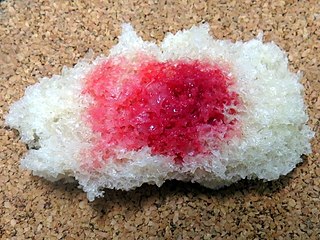
Serratia is a genus of Gram-negative, facultatively anaerobic, rod-shaped bacteria of the family Yersiniaceae. According to the List of Prokaryotic names with Standing Nomenclature (LPSN), there are currently 19 species of Serratia that are credibly published with accurate names as of 2020: S. aquatilis, S. entomophila, S. ficaria, S. fonticola, S. grimesii, S. liquefaciens, S. marcescens, S. microhaemolytica, S. myotis, S. nematodiphila, S. odoriferae, S. oryzae, S. plymuthica, S. proteamaculans, S. quinivorans corrig, S. rubidaea, S. symbiotica, S. ureilytica, S. vespertilionis. They are typically 1–5 μm in length, do not produce spores, and can be found in water, soil, plants, and animals. Some members of this genus produce a characteristic red pigment, prodigiosin, and can be distinguished from other members of the order Enterobacterales by their unique production of three enzymes: DNase (nucA), lipase, and gelatinase (serralysin). Serratia was thought to be a harmless environmental bacteria until it was discovered that the most common species in the genus, S. marcescens, is an opportunistic pathogen of many animals, including humans. In humans, S. marcescens is mostly associated with nosocomial, or hospital-acquired, infections, but can also cause urinary tract infections, pneumonia, and endocarditis. S. marcescens is frequently found in showers, toilet bowls, and around wetted tiles as a pinkish to red biofilm but only causes disease in immunocompromised individuals. Aside from S marcescens, some rare strains of the Serratia species S. plymuthica, S. liquefaciens, S. rubidaea, and S. odoriferae have been shown to cause infection such as osteomyelitis and endocarditis.

Serratia marcescens is a species of rod-shaped, Gram-negative bacteria in the family Yersiniaceae. It is a facultative anaerobe and an opportunistic pathogen. It was discovered in 1819 by Bartolomeo Bizio in Padua, Italy. S. marcescens is commonly involved in hospital-acquired infections (HAIs), particularly catheter-associated bacteremia, urinary tract infections, and wound infections, and is responsible for 1.4% of HAI cases in the United States. It is commonly found in the respiratory and urinary tracts of hospitalized adults and in the gastrointestinal systems of children.

Sulbactam is a β-lactamase inhibitor. This drug is given in combination with β-lactam antibiotics to inhibit β-lactamase, an enzyme produced by bacteria that destroys the antibiotics.
Gelatinases are enzymes capable of degrading gelatin.

Mezlocillin is a broad-spectrum penicillin antibiotic. It is active against both Gram-negative and some Gram-positive bacteria. Unlike most other extended spectrum penicillins, it is excreted by the liver, therefore it is useful for biliary tract infections, such as ascending cholangitis.

Prodigiosin is the red dyestuff produced by many strains of the bacterium Serratia marcescens, as well as other Gram-negative, gamma proteobacteria such as Vibrio psychroerythrus and Hahella chejuensis. It is responsible for the pink tint occasionally found in grime that accumulates on porcelain surfaces such as bathtubs, sinks, and toilet bowls. It is in the prodiginines family of compounds which are produced in some Gram-negative gamma proteobacteria, as well as select Gram-positive Actinobacteria. The name prodigiosin is derived from prodigious.

Swarming motility is a rapid and coordinated translocation of a bacterial population across solid or semi-solid surfaces, and is an example of bacterial multicellularity and swarm behaviour. Swarming motility was first reported by Jorgen Henrichsen and has been mostly studied in genus Serratia, Salmonella, Aeromonas, Bacillus, Yersinia, Pseudomonas, Proteus, Vibrio and Escherichia.

Serratiopeptidase, is a proteolytic enzyme (protease) produced by non-pathogenic enterobacterium Serratia sp. E-15, now known as Serratia marcescens ATCC 21074. This microorganism was originally isolated in the late 1960s from silkworm Bombyx mori L. (intestine), Serratiopeptidase is present in the silkworm intestine and allows the emerging moth to dissolve its cocoon. Serratiopeptase is produced by purification from culture of Serratia E-15 bacteria. It is a member of the Peptitase M10B (Matrixin) family.

A bacillus, or bacilliform bacterium, is a rod-shaped bacterium or archaeon. Bacilli are found in many different taxonomic groups of bacteria. However, the name Bacillus, capitalized and italicized, refers to a specific genus of bacteria. The name Bacilli, capitalized but not italicized, can also refer to a less specific taxonomic group of bacteria that includes two orders, one of which contains the genus Bacillus. When the word is formatted with lowercase and not italicized, 'bacillus', it will most likely be referring to shape and not to the genus at all. Bacilliform bacteria are also often simply called rods when the bacteriologic context is clear.
The E48 particulate bomb was a U.S. biological sub-munition designed during the 1950s for use with the E96 cluster bomb.
Proteases are in use, or have been proposed or tried, for a number of purposes related to medicine or surgery. Some preparations involving protease have undergone successful clinical trials and have regulatory authorization; and some further ones have shown apparently useful effects in experimental medical studies. Proteases have also been used by proponents of alternative therapies, or identified in materials of traditional or folk medicine. A serine protease of human origin, activated protein C, was produced in recombinant form and marketed as Drotrecogin alfa and licensed for intensive-care treatment of severe sepsis. It was voluntarily withdrawn by the manufacturer in 2011 after being shown to be ineffective.
Voges–Proskauer or VP is a test used to detect acetoin in a bacterial broth culture. The test is performed by adding alpha-naphthol and potassium hydroxide to the Voges-Proskauer broth which has been inoculated with bacteria. A cherry red color indicates a positive result, while a yellow-brown color indicates a negative result.

In molecular biology, enzymes in the DNA/RNA non-specific endonuclease family of bacterial and eukaryotic endonucleases EC 3.1.30.- share the following characteristics: they act on both DNA and RNA, cleave double-stranded and single-stranded nucleic acids and require a divalent ion such as magnesium for their activity. A histidine has been shown to be essential for the activity of the Serratia marcescens nuclease. This residue is located in a conserved region which also contains an aspartic acid residue that could be implicated in the binding of the divalent ion.
Serratia marcescens nuclease is an enzyme. This enzyme catalyses the following chemical reaction
Serralysin is an enzyme. This enzyme catalyses the following chemical reaction
Serratia symbiotica is a species of bacteria that lives as a symbiont of aphids. In the aphid Cinara cedri, it coexists with Buchnera aphidicola, given the latter cannot produce tryptophan. It is also known to habitate in Aphis fabae. Together with other endosymbionts, it provides aphids protection against parasitoids.
Serratia entomophila is a species of bacteria that like its cogenerate species uses itaconate. It was first isolated from the grass grub Costelytra zealandica infected with amber disease, suggesting some involvement in the latter. Its type strain is A1T.
Operation Sea-Spray was a 1950 U.S. Navy secret Biological warfare experiment in which Serratia marcescens and Bacillus globigii bacteria were sprayed over the San Francisco Bay Area in California, in order to determine how vulnerable a city like San Francisco may be to a bioweapon attack.
Serratia aquatilis is a Gram-negative and rod-shaped bacteria from the genus of Serratia, which has been isolated from drinking-water systems.

The prodiginines are a family of red tripyrrole dyestuffs produced by Gammaproteobacteria as well as some Actinobacteria. The group is named after prodigiosin (prodiginine) and is biosynthesized through a common set of enzymes. They are interesting due to their history and their varied biological activity.









